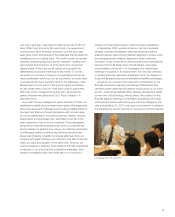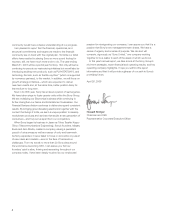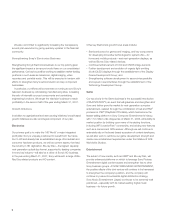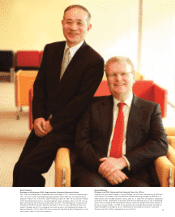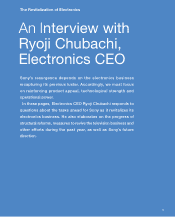Sony 2006 Annual Report Download - page 12
Download and view the complete annual report
Please find page 12 of the 2006 Sony annual report below. You can navigate through the pages in the report by either clicking on the pages listed below, or by using the keyword search tool below to find specific information within the annual report.
10
What important tasks face you in revitalizing
Sony’s electronics business?
It is crucial for us to reinforce product appeal, technological strength
and operational power. Since I became Electronics CEO in April
2005, we have rigorously pursued three corporate initiatives
designed to address these tasks and implemented a reorganization
with the aim of strengthening the Sony Group’s performance.
The first corporate initiative, the “Customer Viewpoint Initiative,”
seeks to effect a change in mindset by encouraging our employees
to view their work from the customer’s perspective. A lack of
sufficient consideration for the customer’s perspective was one
of the key factors behind the decline in product appeal in the first
place. The second is the “Technology No. 1 Initiative,” which
focuses on reinforcing our differentiated technologies in the areas
targeted for the concentrated investment of resources, including
televisions, home video equipment, digital imaging equipment
and Walkman®. The third is the “Genba Initiative,” which aims
to strengthen frontline operations (“genba” in Japanese), that is,
our design locations, manufacturing facilities and sales offices.
The aim of our reorganization was to maximize the collective
capabilities of the Sony Group—from both the customer and
Group perspective. Given the intensely competitive nature of
the digital era, we sought to facilitate efficient, swift, responsive
management by eliminating our internal “Network Company”
system and adopting a new system based on business groups
that clearly identifies key areas of focus. At the same time, we
strengthened horizontal corporate functions. Specifically, while I,
as Electronics CEO, have direct control over all business groups,
we appointed four corporate executive officers—including myself—
to oversee the coordination of product, technology, production,
sales and procurement strategies. This new structure is designed
to avoid the constraints of product-based and organizational
“silos,” which have hindered the development and efficient delivery
of attractive products.
Sony’s Mid-Term Corporate Strategy approaches
structural reform as an urgent task. What
progress have you made so far?
Reforms are proceeding in line with the plan we presented at
the September 2005 Corporate Strategy Meeting, which targets
¥200.0 billion in cost reductions by the end of the fiscal year
ending March 31, 2008. In the period under review, we succeeded
in reducing costs by ¥38.0 billion.
Our first step was to narrow the focus of the Electronics business.
Following up on a comprehensive review based on profitability,
growth potential and relevance to our strategic direction, we
announced that we had selected 15 product categories and would
enact plans to restructure each of these categories through such
measures as alliances with other companies, disposals and down-
sizing. While I can’t give you all the details, I can say that we
subsequently determined and implemented concrete action plans
for nine categories, including plasma televisions, QUALIA products
and entertainment robots. These action plans are expected to
contribute approximately ¥50.0 billion in improved profit during the
fiscal year ending March 31, 2007. We are also striving wherever
possible to shift personnel—especially engineers—from these
categories to growth businesses to ensure the effective use of
human resources.
Another move will be to reduce our total number of manufacturing
sites by 11 by the end of the fiscal year ending March 31, 2008.
We have already completed rationalization of nine of these through
consolidation or closure—two in the United States (Pittsburgh and
San Diego), one each in the United Kingdom (Bridgend) and China
(Beijing) and three in Japan (Iwatsuki, Sakado and Iwane).
You have said that without a recovery in
televisions, Sony’s electronics business will not
recover. What specific measures are you
implementing to revive the television business?
In addition to strengthening the Group’s overall performance, we
must rebuild our television business. In the period under review,
the business posted a loss, owing to intense pricing competition
in the market for flat panel televisions.
We are currently concentrating management resources on
LCD and LCD rear-projection televisions and implementing
essential measures to improve profitability, including reassessing
manufacturing facilities for CRT televisions and centralizing basic
engineering functions. Our target is to make televisions profitable
in the second half of the fiscal year ending March 31, 2007.
We have made a very good start in our bid to revive the television
business. BRAVIA LCD televisions have maintained the top share
of the U.S. market for LCD televisions since their launch in the
period under review. I believe this is because our engineers and
manufacturing and salespeople, finding themselves against the
wall, actually joined forces. The LCD panel used in the BRAVIA (the
Sony Panel)—a seventh-generation amorphous silicon thin-film
transistor (TFT) LCD panel that is particularly suited for large flat
panel televisions—is manufactured by S-LCD Corporation, a joint
venture between Sony and Samsung Electronics Co., Ltd. With
the market shifting indisputably toward large-screen models, sales
of BRAVIA televisions—particularly those with 32-inch and larger





